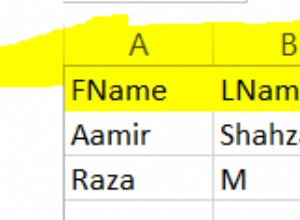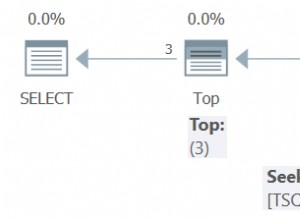Oui; en utilisant le LEAD() fonction analytique, vous pouvez calculer le prochain effdt dans les tables d'emplois et d'avantages, ce qui facilite la recherche entre les plages.
Quelque chose comme :
with dates as (select trunc(sysdate, 'yyyy') - 1 + level the_date,
to_number(to_char(trunc(sysdate, 'yyyy') - 1 + level, 'mm')) monthofyear,
to_number(to_char(sysdate, 'yyyy')) calendar_year
from dual
connect by level <= 365),
jobs as (select 123 emplid, to_date('01/02/2015', 'dd/mm/yyyy') effdt, 900 deptid, 'A' hr_status from dual union all
select 123 emplid, to_date('30/06/2015', 'dd/mm/yyyy') effdt, 900 deptid, 'I' hr_status from dual union all
select 123 emplid, to_date('01/08/2015', 'dd/mm/yyyy') effdt, 901 deptid, 'A' hr_status from dual),
benefits as (select 123 emplid, to_date('01/03/2015', 'dd/mm/yyyy') effdt, 'PPO' benefit_plan, 'A' status from dual union all
select 123 emplid, to_date('31/07/2015', 'dd/mm/yyyy') effdt, null benefit_plan, 'I' status from dual union all
select 123 emplid, to_date('01/09/2015', 'dd/mm/yyyy') effdt, 'HMO' benefit_plan, 'A' status from dual),
-- ********* end of mimicking your tables ********* --
j as (select emplid,
effdt,
deptid,
hr_status,
lead(effdt, 1, sysdate) over (partition by emplid order by effdt) next_effdt
from jobs),
b as (select emplid,
effdt,
benefit_plan,
status,
lead(effdt, 1, sysdate) over (partition by emplid order by effdt) next_effdt
from benefits)
select distinct j.emplid,
d.calendar_year,
d.monthofyear,
j.deptid,
b.benefit_plan
from j
inner join dates d on (d.the_date >= j.effdt and d.the_date < j.next_effdt)
inner join b on (j.emplid = b.emplid)
where d.the_date <= sysdate
and d.the_date between to_date (:year_prompt || '01-01', 'YYYY-MM-DD')
and to_date (:year_prompt || '12-31', 'YYYY-MM-DD') -- if no index on d.the_date, maybe use trunc(the_date, 'yyyy') = :year_prompt
and b.status = 'A'
and d.the_date between b.effdt and b.next_effdt
order by 1, 4, 2, 3;
EMPLID CALENDAR_YEAR MONTHOFYEAR DEPTID BENEFIT_PLAN
---------- ------------- ----------- ---------- ------------
123 2015 3 900 PPO
123 2015 4 900 PPO
123 2015 5 900 PPO
123 2015 6 900 PPO
123 2015 7 900 PPO
123 2015 9 901 HMO
123 2015 10 901 HMO
123 2015 11 901 HMO
(Évidemment, vous pouvez exclure les dates , jobs et benefits sous-requêtes de la requête ci-dessus, puisque vous avez déjà ces tables. Ils ne sont présents dans la requête que pour simuler la présence de tables contenant ces données sans avoir à créer réellement les tables.).
ETA :Voici une version qui calcule simplement les 12 mois en fonction de l'année écoulée, ce qui réduit les lignes de date à 12, au lieu de 365/366 lignes.
Malheureusement, vous aurez toujours besoin du distinct, pour tenir compte du moment où vous avez plusieurs lignes commençant le même mois.
Par exemple, avec les données de l'exemple suivant, vous vous retrouveriez avec 3 lignes pour le mois 6 si vous supprimiez le distinct. Cependant, le nombre de lignes sur lesquelles opère la distinction sera bien inférieur à ce qu'il était auparavant.
with dates as (select add_months(to_date(:year_prompt || '-01-01', 'YYYY-MM-DD'), - 1 + level) the_date,
level monthofyear,
:year_prompt calendar_year -- assuming this is a number
from dual
connect by level <= 12),
jobs as (select 123 emplid, to_date('01/02/2015', 'dd/mm/yyyy') effdt, 900 deptid, 'A' hr_status from dual union all
select 123 emplid, to_date('15/06/2015', 'dd/mm/yyyy') effdt, 900 deptid, 'I' hr_status from dual union all
select 123 emplid, to_date('26/06/2015', 'dd/mm/yyyy') effdt, 900 deptid, 'A' hr_status from dual union all
select 123 emplid, to_date('01/08/2015', 'dd/mm/yyyy') effdt, 901 deptid, 'A' hr_status from dual),
benefits as (select 123 emplid, to_date('01/03/2015', 'dd/mm/yyyy') effdt, 'PPO' benefit_plan, 'A' status from dual union all
select 123 emplid, to_date('31/07/2015', 'dd/mm/yyyy') effdt, null benefit_plan, 'I' status from dual union all
select 123 emplid, to_date('01/09/2015', 'dd/mm/yyyy') effdt, 'HMO' benefit_plan, 'A' status from dual),
-- ********* end of mimicking your tables ********* --
j as (select emplid,
trunc(effdt, 'mm') effdt,
deptid,
hr_status,
trunc(coalesce(lead(effdt) over (partition by emplid order by effdt) -1, sysdate), 'mm') end_effdt
-- subtracting 1 from the lead(effdt) since here since the original sql had d.the_date < j.next_effdt and we need
-- to take into account when the next_effdt is the first of the month; we want the previous month to be displayed
from jobs),
b as (select emplid,
trunc(effdt, 'mm') effdt,
benefit_plan,
status,
trunc(lead(effdt, 1, sysdate) over (partition by emplid order by effdt), 'mm') end_effdt
from benefits)
select distinct j.emplid,
d.calendar_year,
d.monthofyear,
j.deptid,
b.benefit_plan
from j
inner join dates d on (d.the_date between j.effdt and j.end_effdt)
inner join b on (j.emplid = b.emplid)
where d.the_date <= sysdate
and b.status = 'A'
and d.the_date between b.effdt and b.end_effdt
order by 1, 4, 2, 3;
EMPLID CALENDAR_YEAR MONTHOFYEAR DEPTID BENEFIT_PLAN
---------- ------------- ----------- ---------- --------------------------------
123 2015 3 900 PPO
123 2015 4 900 PPO
123 2015 5 900 PPO
123 2015 6 900 PPO
123 2015 6 900 PPO
123 2015 7 900 PPO
123 2015 9 901 HMO
123 2015 10 901 HMO
123 2015 11 901 HMO




